January 11 - 17, 2015: Issue 197
Bob Head
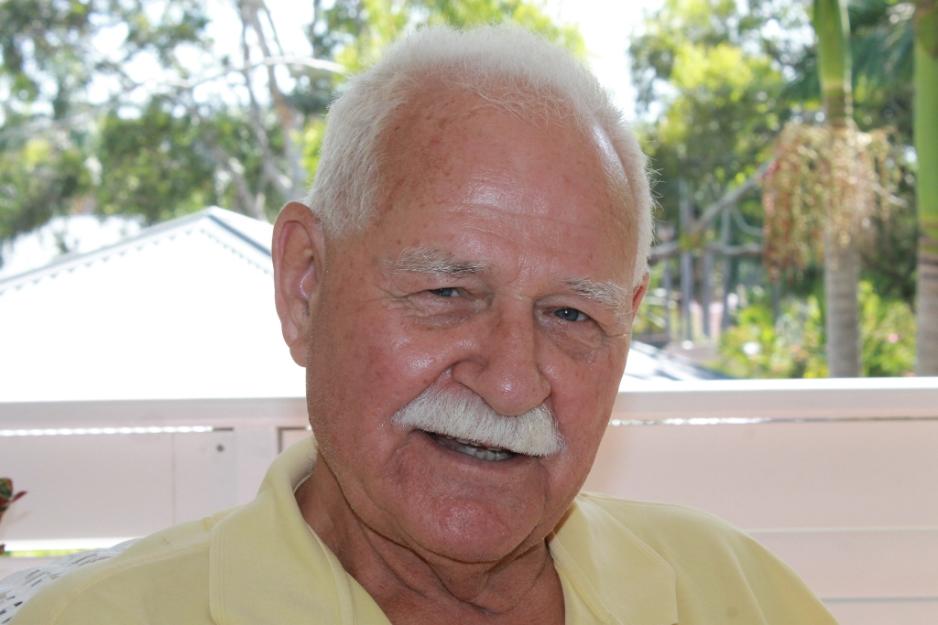
Bob Head
Former Patron and Life Member at Avalon Beach SLSC – a saltwater man whose eyes light up when he speaks of favourite waves and sailing, Mr. Head’s 70 years beside the sea, and some of what he has done, makes him a legend to many who came long afterwards. He prefers the beach when it’s empty, quiet though…shrugs off success as ‘being in the right place at the right time’ – when sometimes, being in the right place at the right time sets off a spark that lights up the path of others and inspires fundamental shifts for the better just by someone being themselves.
When and where were you born?
I was born in Gordon in 1941. We lived on the North Shore until I was about 3 ½ and moved to Newport in 1944. Newport was dirt roads then, we’d get around in bare feet. Schooling was at Newport Public school – everybody went to Newport Public, there was no other school. The headmaster was a man called Sanderson.
What did you learn there?
Maypole Dancing, how to kiss…
Where did you go to High School?
What they called ‘Shack City’, which was originally Manly Boys High School and eventually became Balgowlah Boys High School when Manly moved to Brookvale. These were great schools.
What did you do when you left school?
I went to work for a large international company called ‘Unilever’. While there my work involved sales and marketing until I was 21 when a group of us went overseas.
The Malibus – surfing – how did that all begin?
That all started in 1956 when the Americans came over here – that was a great morph, it changed everything overnight, people who weren’t interested in surfing became surfers.
Having joined Newport Surf Club when I was 12 a move to Avalon Beach SLSC by 14 came about as I was a very competitive swimmer more than anything, and the Avalon people enticed me there for want of a better word.
How did the trip overseas eventuate?
There were four friends; Warren Mitchell, who in his own right became famous because of the rubber duckie, a chap called John Campbell, myself and Ian Tiley. Three of us joined the military at George’s Heights in Mosman. Obviously we learnt a lot of skills there.
While the Malibu phenomenon was evolving and we were riding Malibus and surfing up and down the coast and attending military service, there was an advertisement in the paper for Lifeguards in Cornwall, U.K.. This wasn’t just any old Lifeguard job, each person was going to be allocated a large section of the coast to look after. We also worked with the Royal Air Force using helicopters and had to retrieve people who had fallen over 300 foot cliffs.
We applied and were accepted for the jobs.
We took off over there with our surfboards under our arms and went to our various beaches and worked as Lifeguards.
Just like here, the public showed a huge interest – they’d never seen anybody standing up on a surfboard. Let alone doing what we could do with the Malibus, going backwards and forwards across the waves.
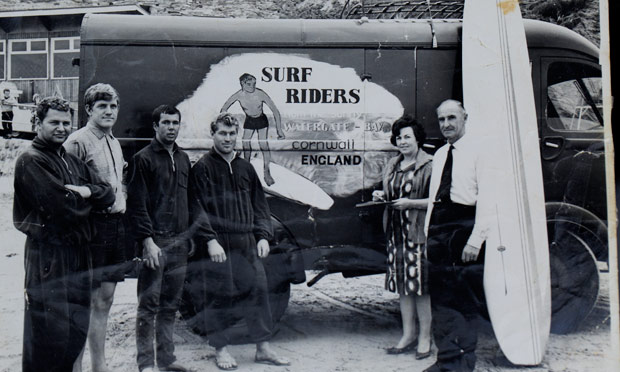
Left to right: Bob Head, John Campbell, Ian Tiley, Warren Mitchell.
You were using them as rescue devices as well?
We had to because we worked on our own. It was extremely dangerous – on some of the beaches there were large numbers of people who wanted to help you. You had a reel and line and belt like we had here, or a box line and belt which you would have to carry up and down with the tidal movement. If you had to rescue somebody, as happened with Warren Mitchell; he took off in the belt and had to swim out quite a way – he had a jeep on his beach because it was about two miles long – the people thought they would help and because they couldn’t pull him in against the weight of the surf, they tied the line to the jeep and pulled him out with the jeep and actually pulled him under.
Hence the reason we stopped using the line and belt – too many trying to help were nearly killing us. So we’d just use our surfboards and that’s actually also the beginning of the rubber duckie because way back then Warren used to say ‘well, we can only get one or two on our surfboards, we’ve got to get something better’. Because we’d used these rubber inflatable boats in the Army, Warren said ‘I think these can work in the surf’.
He started working on that over there and subsequently pushed through with that here for which he was award the ‘O.A.’.
While you were there you were part of initiating the surfing industry in Cornwall too – and this is one of the largest surfing industries in the world now?
I think it’s the biggest income for Cornwall now and I believe is now credited as being the largest tourism industry there.
Were you aware then of what you’d started?
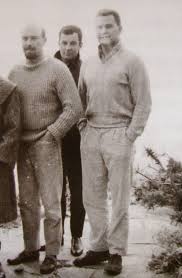 No idea. It was expediential – in the first year we just rode our surfboards and over the Winter people said ‘where do you get them?’, ‘how do we get them?’
No idea. It was expediential – in the first year we just rode our surfboards and over the Winter people said ‘where do you get them?’, ‘how do we get them?’
We use to say you can write to Australia – but the cost was enormous so we began making them. I was, unknowingly, doing it in parallel with an English fellow, Bill Bailey, who subsequently became my partner, investigating how to get products and materials in order to make surfboards.
Right: Bill Bailey, Doug Wilson and Bob Head, September 1962, Mawgan Porth
We’d do this in the Winter – when my customers launched their boards, my first five, that interested another fifty people. From that 50 came 200 people – it went crazy.
Within 12 or 18 months Bill and I had to join forces to be able to meet demand.
How long were you there?
About five years.
Didn’t you marry an English girl while there?
Yes – the Winter’s are very long. I met Terri, my first wife, in Cornwall – she was a Londoner who had come down to Cornwall for the Summer. I was the lifeguard on a beach some six miles out of Newquay called Mawgan Porth, where she was staying with friends.
I’d be on the beach and she’d come down – the attraction was there – I’d see her over at the local pub, which was a focal point after the day ended for everybody- people would go the pub and have a pint of Scrumpy or whatever they wanted.
Cornwall was very village like then. The difference between Summer and Winter was very marked – during Winter the population of Mawgan Porth could not have been any more then 300, in the Summer it would be 2000.
When did you come home?
We went over in 1962, and I stayed five years, must have been 1967 or late ’66.
What did you do when you came home – make more surfboards?
No, I only ever made surfboards in the UK – we used to, as they still do today, hang around surfboard shops in Brookvale, particularly a fellow called Scott Dillon – I’d watch them make these and that stuck in my mind and assisted me when I started to make boards in the UK.
When I returned here there wasn’t the time to go surfing as I had a new family and had to get work to support them. First of all I worked with my brother, who was a builder.
After some years I got a job with a company called World Wide Camps which later became a company called ATCO. They manufactured those boxes you see on building sites – potable demountable sheds. They made these for mining camps in remote areas. Having worked for them for a few years visiting all the mining companies trying to sell them these camps, and due to a connection I’d made in France years ago, I got involved with some French fellows who provided the ongoing services to these mining camps; this included catering, cleaning, security, pretty much everything except doing the mining – they provided the logistical services that kept these camps going. I worked there for a few years and then went out on my own and started a company called AFCO and built that company up until it was the largest Australian company of its type. At our peak we had close to 1200 or 1500 hundred employees.
The company provided a range of logistical services and then that too also grew exponentially – towards the end of that business the military privatised and AFCO became involved with taking over military service operations too – the closest and largest one would be Endeavour House at Coogee for the Royal Australian Navy – we ran that for years and years, as we did other operations.
The area we worked most in was the Middle East, Borneo, South East Asia, the Pacific Islands as well as all of Australia. I was travelling all of the time.
How many children did you have?
Two boys – two great boys, Paul and Mark, and then a stepson with my 2nd wife Robin, another Mark. They didn’t get to see me enough during those early times.
You seem to have a knack for building successful businesses…
I think it’s just being in the right place at the right time – I was never the greatest surfboard manufacturer, some of my boards left a lot to be desired. When in partnership with Bill Bailey we created the company called ‘Bilbo’, which is still the largest brand name in Europe. Bill was an Air Force technician and he did everything by the book. He taught me more than I taught him. My contribution to Bilbo was more surfing skills, demonstrations, although I was the shaper for Bilbo for at least two years.
What does it take to be a successful business man, apart from being in the right place at the right time?
The first thing you’ve got to have is belief in yourself, belief in the product, and then commitment. No matter what you need to stick to your guns and keep going. Be genuine.
Where is your favourite wave?
Well, remembering it’s Malibus and not the short boards, which would be a different answer for both – I suppose Angourie or Byron as far as Australia is concerned.
Why those waves?
For Byron it would be the length of the ride and at Angourie it would be the shape. If you said the biggest, not that I visited everywhere but certainly surfed quite a few, the biggest would be a wave called the Cribbar in Newquay, and that was a 30 foot wave, of which there are several photos.
There are quite a few people who claim to have ridden that for the first time but, as far as we know, we actually rode it two years before anybody else. That was always my favourite wave because it would come on in September of every year.
September 1965. Caught inside by a Cribbar set, Bob Head (left) swims for it while Jack Lydgate prepares to take a beating. Bob’s 9’6” gives a clue to the size of the waves.
When was the surfboard used as rescue equipment here?
It was used in the UK before Australia. We had the reel, line and belt here, then we moved to the torpedo buoy – it was too obvious. Rescues were going on all the time by using surfboards but that was mainly by surfers seeing someone in trouble and paddling over and helping them. They weren’t on the beach as they are today as a standard piece of lifesaving equipment for a long time.
We used them in Cornwall because it was a necessity – we had to, we had nothing else – these were one man operations.
You joined Avalon Beach SLSC in 1956…what was it like then?
Norman Cook was the patron – it was a fantastic club. I got my Bronze Medallion in 1957 and was a very competitive swimmer.
We used to have a region called the 8, 9,10 Zone, which was surf clubs between Warriewood and Palm Beach, that was our area. (If you wanted to move out of that area then you became part of the Metropolitan competitions) – which had about nine beaches in that group - and there would be a Carnival every weekend at one of those beaches over the Summer period. In those days you’d compete in everything – the surf race, belt race, the board race, musical flags, the pillow fight – the famous kegs of Avalon.
What was your best result?
Well, I suppose my best result was when I won several events at the British Championships (1963) and won the belt, the surf and the board at the same event. Competition in the U.K could be hard. We had South Africans coming over, Americans, - so there was a lot of international competition, it wasn’t just the locals.
In Australia I had successes in surf and belt races at carnivals over a long period.
When you joined surf lifesaving, what was the best thing about it for you?
The mateship, camaraderie – especially at Avalon. North Palm Beach was like this too, although it was a much smaller clubhouse than what they have today of course – they had a bunkhouse – so all the boys would come down and stay there, and although I lived at Newport I’d commute daily. The majority of the club members would live in the city area and in my day they came from North Sydney, that area, and mainly from the Police Boys clubs.
In each local club there’s a link with elsewhere during their early years – Bilgola members came from Gordon, St Ives and Lindfield way. Most of those clubs were fed by people who came from the North Shore.
Nowadays I probably play golf more than anything, and have played golf socially for most of my adult life. Palm Beach is where I play and was the president there for four years, which was 8 hours a day, 7 days a week love job.
That’s a lot of voluntary work each week! You’re also a member of Palm Beach RSL Sub-Branch from your service in Reserves and do voluntary work there as well?
Yes; I joined at Palm Beach. I seem to remember that it was felt somewhat prudent to join out of your own suburb. So I wasn’t going to join too far away, and had friends at Palm Beach, and joined there.
When I finished being president of the Golf Club, and went through over two years of hospitalisations for hip and knee problems, John Oliver and the local president, Mark Ferguson, asked me if I’d like to become a member of the Sub-Branch Committee – they then asked if I’d like to become one of the Directors. At the first meeting I was informed they had a vacant position for a Welfare and Pensions Officer and have ended up in that position.
So you are now visiting the Veterans Centre at Narrabeen regularly?
Yes, there are courses held for all sub-Branch and pension officers to maintain their currency as a Welfare Officers.
In view of your experience at George’s Heights, and returning to Australia during the 1960’s – how did you react to the way Australian service people returning from Vietnam were treated?
Vietnam was just starting as we left to go to the UK, and when I say just starting, they were actually pulling what they call advisors from our unit to go over there. In fact one of the VC winners came from our unit, (1.CDO Coy).
For me, I was too young to have an opinion – I was still at the gung-ho stage – I was in there for the mateship once again as opposed to thinking about the reality of it, politically or what that being part of it may be about.
The 1970’s, when service people were returning home and experiencing persecution and vilification for serving – did you have an opinion about that then?
Absolutely. What happened to those boys was absolutely terrible. I’ve had a lot of time and experience, working with a lot of these people, to think it through more clearly.
I blame the media – ever since day one men have been at it for whatever reason, killing each other – but, it wasn’t as publicised as this war was. Vietnam was the first war where the cameras were there while it was happening. All of a sudden the people at home, who usually didn’t see that sort of thing, were horrified. So they took a position against the Veterans and it was terrible.
The Veterans did nothing more or less than had happened in every other conflict ever. The treatment they received is perhaps ‘Australia’s greatest shame’.
You’ve been around Newport and Avalon for close to a century now Bob…
Two centuries…
What’s the best thing about growing up on the Northern Beaches?
I used to like the simple life, and still do like the simple life and I wouldn’t be on my own if I said when the silly season arrives I get a bit testy. I don’t like driving down to the shopping car parks and have everybody driving against me because they don’t know any better when I’ve been following the arrows for years – so that does put the temperature up a bit – but I understand it because I’ve done it myself in other locations, been the tourist.
Other than those times, and even then if you get up early enough, it still is pretty simple and good down there – if you get down the beach at 7am it’s just fantastic.
What is your favourite place in Pittwater and why?
Avalon Bowlo, for the peace and quiet – because it’s still the olde worlde place it was years ago and, like other clubs, I’m noyt politically involved. I actually like sitting on our verandah here at home too. It has its attractions.
Sailing too has long been a passion – I’ve had several boats; 60-footers, ketches. I’ve sailed up from Victoria to Sydney in my ketch.
You have saltwater in your blood Bob.
I suppose so – I’ve paddled my ski from Newcastle to Sydney, and this is 50 years ago.
What is you motto for life or a favourite phrase you try to live by?
Enjoy yourself – life is too short not to. Anything can happen.
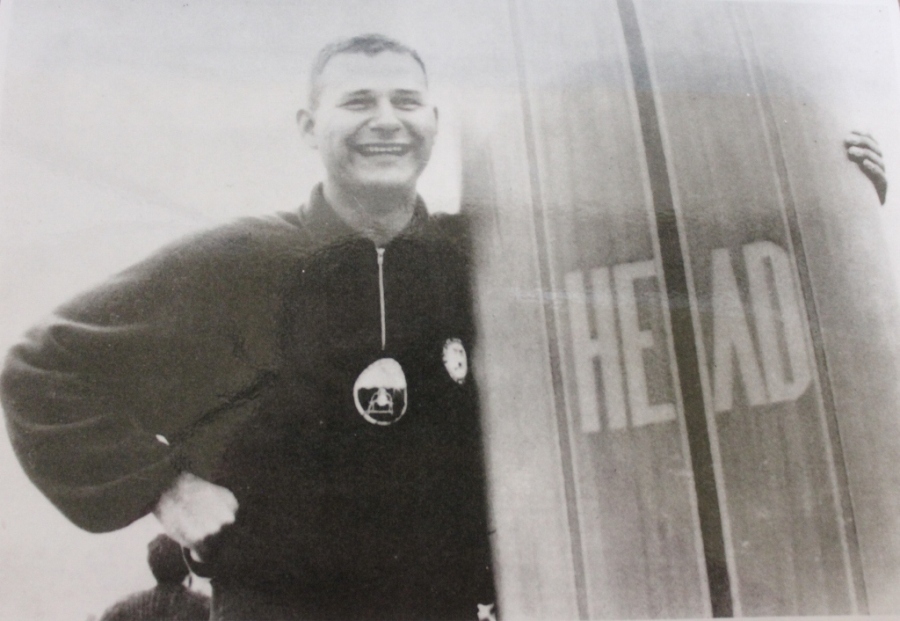
Bob Head with one of his Malibu boards
Aussie lifeguards and locals, September 1962 Mawgan Porth - l to r Ian Tiley, unknown, Warren Mitchell, Doug Turner, John Campbell, Bill Bailey, Doug Wilson, Bob Head
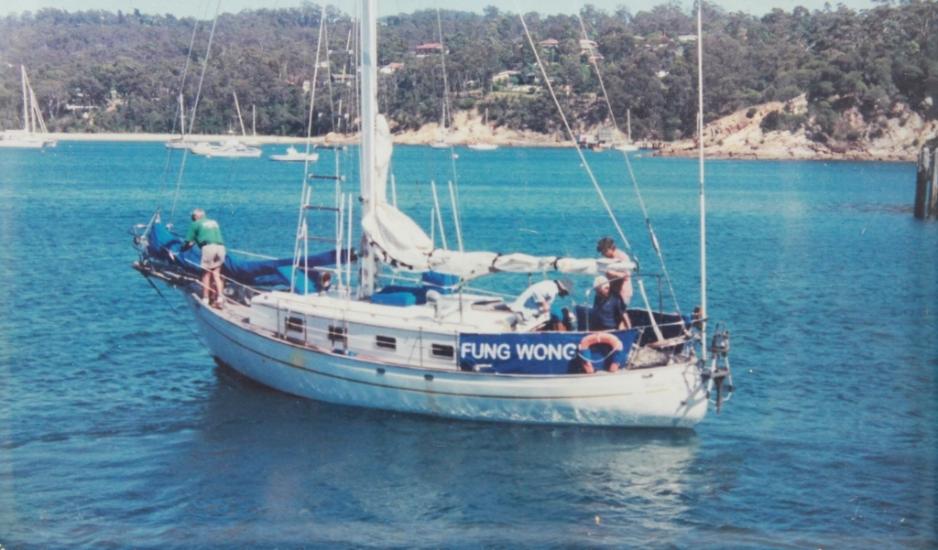
One of Bob's boats - Fung wong – Chinese – means ‘phoenix’.
Bill Bailey started producing his custom model boards in a Newquay garage in 1963, and Bob Head quite separately was making his 'Friendly Bear' surfboards in a chicken shack up the coast. Some owners claim it was rare to get a board without a few feathers or chicken tracks as part of them. At this time Bob was considered the finest surfer in the U.K. The Mal Bob took to the U.K. was a Scott Dillon board - the one here is a 'Friendly Bear' - courtesy UK:
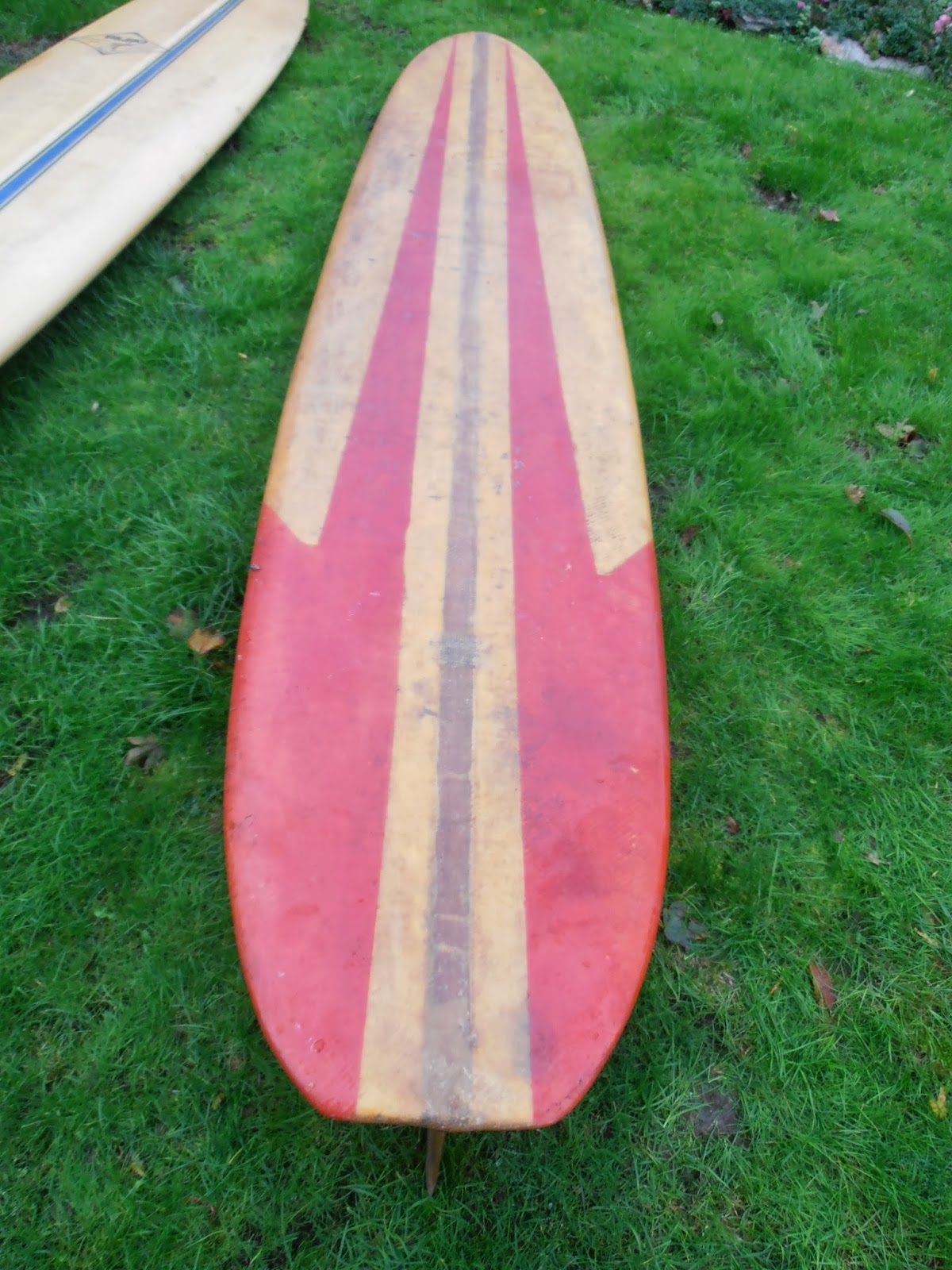
A few extras:
Arrival of the Mal - 1956 Surf Boards: the Avalon Beach Historical Society held a special meeting with Talks given by David Lyall and Bob Head providing some great insights into the ‘Arrival of the Mal’ or Malibu surfboards in Pittwater.
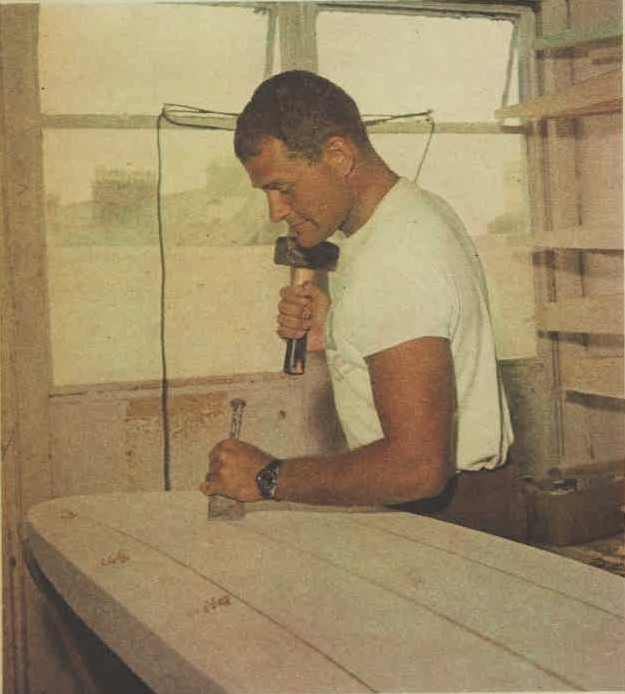
BOB HEAD, from Newport, N.S.W., works on a surfboard. He set up the factory and shop at Newquay with three English partners and sells Malibu boards in England and on the Continent for well under half the price of the boards imported from America. "SURFIES" OF CORNWALL. (1965, October 20). The Australian Women's Weekly (1933 - 1982), p. 22. Retrieved from http://nla.gov.au/nla.news-article57961104
SURFING- WHALE BEACH CARNIVAL -Rand r Newport 72 6 I Avalon 69 22 Whale Beach 67 55 3 Senior surf H Bailey (Whale Beach) 1 K Murieil (Palm Beach) 2 Marvel (Newport)3 Teams race Palm Beach 1 Mona Vale 2 Whale Beach 3 Junior surf A Ramsay (Whale Beach) 1 Mears(Palm Beach) 2 Dickson (Mona Vale) 3 Teams race Mona Vale Senior belt H Bailey (Whale Beach) 1 Hotten (Newport) 2 K Murrell (Palm Beach) 3 Junior belt race A Ramsay(Whale Beach) 1 B Head (Avalon) 2 H Käufer (Mona Vale) 3 Senior boat race Mona Vale 1 Newport 2 Avalon1 Junior boat race Mona Vale I Avalon 2 Palm Beach 3 Board race K Davidson (Avalon) 1 W Swanton(Palm Beach) 2 G Jeffries (Newport) 3 Ski race Wallis (Newport) Wood (Avalon) 2 Claire (Mona Vale) Beach sprint Harrison (Newport)Livingston (Newport) 2 Aubrey(Newport) 3 Points for trophy Newport 3 Whale Beach 2 North Palm Beach 1 Beach relay Whale BeachI Mona Vale 2 Avalon 3 Musical flags North Palm Beach 1 Whale Bench 2 Newport 3 SPORT DETAILS. (1950, January 2). The Sydney Morning Herald (NSW : 1842 - 1954), p. 6. Retrieved from http://nla.gov.au/nla.news-article18142893
SURFING - AVALON-Surf race H Usher 1B Head 2 R Single J Belt H Ragan 1 J Thompson 2 N Mccredie1 Ski R Woods 1 N Davidson 2R Payne 1 Beach sprint J Cameron 1 A Slevin 2 J Campbell 1 Board R Single I 1 Golrle 2 K Davidson1 junior belt B Head1 B Cutting2 N Davidson 3. GENERAL SPORT DETAILS. (1949, December 19). The Sydney Morning Herald (NSW : 1842 - 1954), p. 6. Retrieved from http://nla.gov.au/nla.news-article18145610
AVALON-Club championships final round Senior surf race H Ragan 1B Crane 2 N McCready 3 Cadets and probationary surf race F Donaldson 1 B Head 2 N Head 3 Surf Details. (1949, February 28). The Sydney Morning Herald(NSW : 1842 - 1954), p. 6. Retrieved from http://nla.gov.au/nla.news-article32153309
Surfers Celebrate 50th Anniversary of Arrival of Malibu Surfboards in Cornwall
PRESS RELEASE - April marks an important anniversary for UK surfers. Fifty years ago, in the spring of 1962, a small band of Australian and American surfers arrived in Newquay with fibreglass 'Malibu' surfboards. Their presence in Cornwall that summer provided the catalyst for surfing to take off in mainland Britain.
The Aussies - Bob Head, John Campbell, Ian Tiley and Warren Mitchell - had travelled to Britain in search of adventure, girls, jobs and, of course, waves. They were all qualified lifesavers and members of Avalon Surf Life Saving Club, (based just north of Sydney), and with their qualifications they hoped to find summer lifeguard jobs in Cornwall. Beach safety was a real issue on the north coast of Cornwall at that time (there had been 16 drownings the previous year), and the four Aussies quickly secured jobs at the beaches just north of Newquay. Their presence watching over the throngs of holidaymakers at Watergate, Mawgan Porth and Treyarnon that summer had a major effect; they performed scores of rescues and undoubtedly saved many lives. But it wasn't just their lifesaving feats that got them noticed. The four Aussies were all skilful surfers, and they rode a type of board that had never been seen before on the UK mainland, the Malibu. Casually gliding along the pristine turquoise waves, the Aussie surfers truly were a sight to behold. The local Cornish lads were gobsmacked.
"I was an 11-year-old kid playing in the waves with my plywood bellyboard at Great Western Beach, when I saw a man gliding across a wave, standing up," recalls Roger Mansfield, author of The Surfing Tribe, the definitive history of surfing in Britain. "I didn't believe it at first. I didn't know what to call it either, it was so totally new and alien. I immediately wanted to find out more. A few weeks later I had my first go on a borrowed surfboard...and within a year I was a surfer with my own Malibu board."
Prior to 1962, stand-up surfing in mainland Britain had only been fleetingly achieved by a few plucky pioneers riding hollow wooden 'cigar-box' boards, and later by a small number of lifeguards who occasionally cruised a few waves (riding straight in to the beach) on their hollow wooden rescue boards. But wooden boards were heavy, clunky, finless and almost impossible to turn; they had no mass appeal, and consequently surfing had never caught on.
Malibu boards were light-years ahead in comparison. Their streamlined shapes and lightweight construction made them responsive and manoeuvrable, allowing surfers to ride along the waves, and even perform tricks.
In terms of functionality, Malibu boards were a revelation. "Compared to the earlier hollow wooden surfboards, the Malibus were much lighter and easier to carry, and much more manoeuvrable on the waves," says Mansfield. "They were built using new materials: a core of high-density polyurethane foam encased in a hard covering of fibreglass cloth and resin, the fibreglass 'skin'. A vital addition was the fin at the tail of the board which allowed the surfer to steer and manoeuvre his board along the wave."
The four Aussies had been riding Malibu boards since 1956, and Bob Head and John Campbell were recognised as two of the top surfers in the Sydney area. On their days off (if the waves were good) the Aussies would drive into Newquay and surf with the Brit lifeguards stationed there, Bill Bailey and Richard Trewella, who were eager to learn the wave-riding skills of the Aussies.
The international cast for the launch of surfing in Newquay grew further when American lifeguard and surfer John Lydgate arrived in the summer of '62. Mahogany Jack (as he became known) was a tall, tanned, post-grad student who'd been to high school in Hawaii where he'd learnt to ride big waves.
Bob Head and Jack Lydgate were now the best surfers in town, and both became instant heroes to the local beach-going youngsters who watched them cruise effortlessly along the Cornish waves. Their mastery of the surf had a huge impact on Newquay lads like Roger Mansfield. On land too they were always the centre of attention at social gatherings like beach barbecues.
"The Aussie lifeguards told tales of another world Down Under, where beach life was a central part of the culture. We all listened to the stories, fascinated. And, of course, their surfing skills were just incredible."
At the end of the '62 season, Brit lifeguard Bill Bailey had time to reflect on a revelatory year. Thanks to the combined efforts of the lifeguards, beach safety in the Newquay area had improved dramatically. Convinced that the Malibu board was an essential piece of kit for lifeguards, he wrote to the local council strongly recommending that they obtain several such boards before the start of the next season. The council agreed and handed Bill the task of building six Malibu boards by the following spring. Figuring out how to do this involved months of research and experimentation...but he eventually completed the six rescue boards, and they were used throughout the following season by the Newquay lifeguards.
Since Bill Bailey now knew how to make Malibus, some of the Newquay lads began asking if he could make surfboards for them. Before long, Trevor Roberts, Paul Holmes, Alan McBride and Dave Friar had each forked out £25 for a board of their own, and they joined 'locals' Bill, Richard Trewella, Mahogany Jack and the Aussies in the Newquay lineups.
Aussie lifeguard Bob Head also liked the idea of making a few boards in his spare time, so he gave it a go in a disused chicken shed up at Mawgan Porth.
Over the following years the number of boards built in Cornwall continued to grow exponentially. By 1965 the demand was so great that Bill and Bob decided to jack in their lifeguard jobs and go into board production full-time, together. Bilbo Surfboards was born.
"Bill knew how to blow foam blanks and we both knew how to shape boards, so we just thought we should put our heads together," says Bob. "Bill was more of a perfectionist than I was...he actually steadied me up and said I should take more time doing this and that, so the quality of the boards gradually became better and better. I think we made rather a formidable team in those days."
Bilbo went on to become the biggest UK surf brand of the era, producing many hundreds of boards (and other products) each year from their factory in Newquay.
In the space of just a few short years a whole surfing culture and industry had developed in the Southwest, inspired at the outset by those four young Aussies who first showed up in Newquay in April 1962. From: http://www.surfline.com/surf-news/_68581/
Copyright Bob Head, 2015.